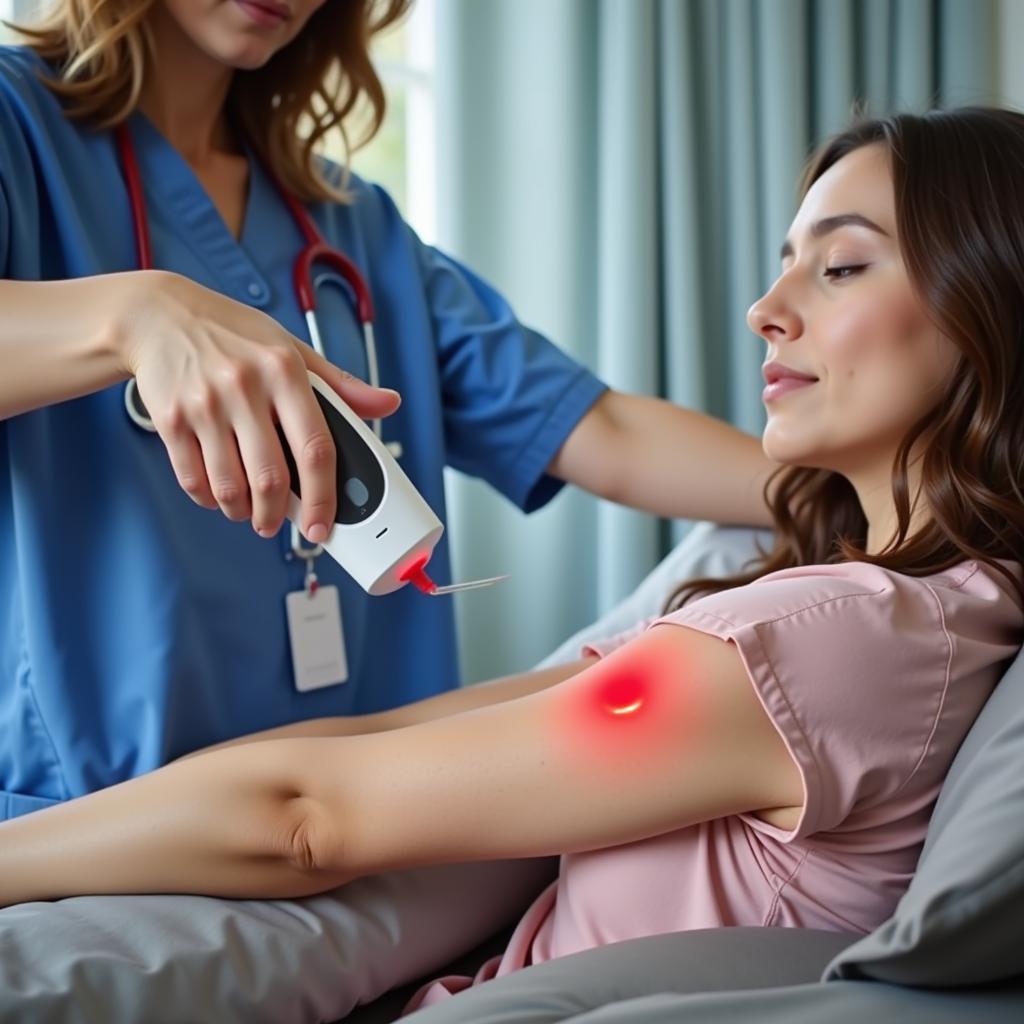Hospital Vein Finders are becoming increasingly vital in healthcare settings, providing a crucial tool for medical professionals to quickly and accurately locate veins for IV insertions, blood draws, and other procedures. This technology enhances patient comfort, reduces complications, and improves the overall efficiency of care. Let’s explore the world of hospital vein finders and understand their significance in modern medicine. vein finder hospital
What is a Hospital Vein Finder?
Hospital vein finders, also known as vein viewers or vein illumination devices, utilize near-infrared light to visualize the network of veins beneath the skin’s surface. This technology projects a real-time image of the veins onto the skin, allowing clinicians to identify suitable veins for various medical procedures. This is especially helpful in patients with difficult veins, such as the elderly, obese individuals, or those with dark skin tones.
How Does a Vein Finder Work?
Vein finders emit near-infrared light, which is absorbed by hemoglobin in the blood and reflected back by surrounding tissue. The device then processes this reflected light to create a map of the veins, displayed directly onto the patient’s skin. This allows for precise needle placement and minimizes the risk of multiple punctures.
 Hospital Vein Finder Technology in Action
Hospital Vein Finder Technology in Action
Benefits of Using a Hospital Vein Finder
The advantages of using a vein finder are numerous, impacting both patients and healthcare providers:
- Improved Patient Comfort: By reducing the need for multiple needle sticks, vein finders significantly decrease patient discomfort and anxiety, particularly for those with a fear of needles.
- Increased First-Stick Success Rates: Vein finders improve the accuracy of venipuncture, leading to higher first-stick success rates and reducing the need for repeat attempts.
- Reduced Complications: Accurate vein location minimizes the risk of complications such as hematomas, nerve damage, and infiltration.
- Enhanced Efficiency: By streamlining the process of vein location, vein finders save valuable time for both clinicians and patients.
- Improved Patient Safety: Clear visualization of veins reduces the risk of accidental arterial punctures.
Different Types of Vein Finders
There are various types of vein finders available, each with unique features and functionalities:
- Handheld Vein Finders: Portable and versatile, these devices are ideal for use in a variety of clinical settings.
- Desktop Vein Finders: These larger units are typically used in specialized areas such as operating rooms or emergency departments.
- Wearable Vein Finders: A newer innovation, these devices offer hands-free operation, allowing for greater flexibility during procedures.
Choosing the Right Hospital Vein Finder
Selecting the appropriate vein finder depends on various factors, including the specific needs of the facility, the patient population served, and the budget. hospital grade vein finder
Factors to Consider:
- Image Quality: Clear and high-resolution images are essential for accurate vein identification.
- Portability: Handheld devices offer greater flexibility and are suitable for various settings.
- Ease of Use: The device should be user-friendly and intuitive for healthcare professionals.
- Durability: The vein finder should be robust enough to withstand regular use in a clinical environment.
- Cost: Consider the overall cost of the device, including any ongoing maintenance or consumables.
“Investing in high-quality vein finder technology is an investment in patient care,” states Dr. Emily Carter, a leading phlebotomist. “It not only improves the patient experience but also enhances the efficiency and safety of our procedures.”
The Future of Vein Finding Technology
The field of vein finding technology is constantly evolving, with ongoing research and development focused on improving image quality, portability, and functionality. Future advancements may include:
- Integration with other medical devices: Vein finders may be integrated with IV insertion systems or blood draw equipment.
- Enhanced imaging capabilities: Future devices may offer 3D imaging or other advanced visualization techniques.
- Artificial intelligence integration: AI-powered vein finders may be able to automatically identify the optimal vein for access.
Conclusion
Hospital vein finders are transforming the landscape of vascular access. By providing clear and accurate visualization of veins, these devices are improving patient comfort, enhancing clinical efficiency, and minimizing complications. middlesex hospital wait times As technology continues to advance, hospital vein finders will undoubtedly play an increasingly important role in delivering high-quality patient care.
FAQs
- Are vein finders safe for patients?
- How much does a hospital vein finder cost?
- What are the different types of vein finders available?
- How do I choose the right vein finder for my hospital?
- What are the benefits of using a vein finder?
- How does a vein finder work?
- What is the future of vein finding technology?
Common Scenarios Where Vein Finders Are Helpful:
- Patients with difficult veins due to age, obesity, or medical conditions.
- Emergency situations where rapid IV access is critical.
- Pediatric patients where vein access can be challenging.
- Patients undergoing chemotherapy or other treatments requiring frequent venous access.
Further Reading
For any support or inquiries, please contact us:
Phone: 02437655121
Email: [email protected]
Address: 298 Cau Dien Street, Minh Khai, Bac Tu Liem, Hanoi, Vietnam.
Our customer service team is available 24/7.